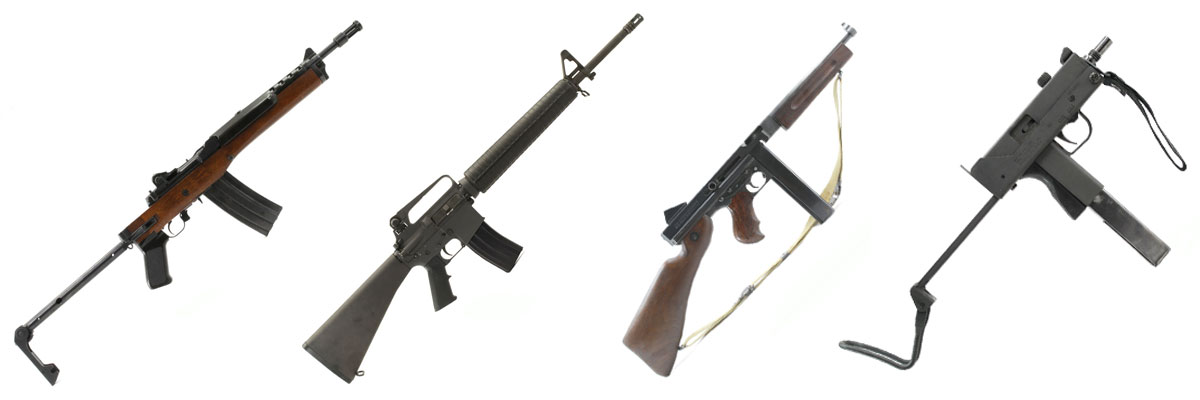Buying A Machine Gun
Buying a Machine Gun
As NFA items have dramatically increased in popularity, most serious enthusiasts are aware of the legality of suppressors, short barrel rifles, and shotguns. For seasoned owners of NFA items, they realize the process is not as complicated as many think. Even with the ever growing presence of suppressors and short barrel rifles, one area of NFA ownership still remains unknown to some. Machine guns, while legal in most places, still have an aura of mystery surrounding them. In this article we'll look into the different classifications, expense, process for ownership, and types of common privately accessible machine guns.
Select fire weapons fall into three categories, these being pre-sample, post-sample, and transferable. Pre-sample machine guns were imported between implementation of the Gun Control Act of 1968 and the Hughes Amendment (attached to FOPA) in May of 1986. Pre-sample machine guns may be bought and sold between licensed dealers without the need of a demo letter. Any select fire or automatic firearm made after May 19, 1986 is considered a post-sample. Post-sample machine guns can only be possessed by manufacturers, law enforcement, military, and dealers with specific letters from law enforcement. This leaves us with the last category of transferable machine guns. Transferable machine guns are able to be privately owned and collected if allowed by state law.
Any machine gun available for private purchase must have been made and registered before May 19, 1986 or imported and registered before 1968. This creates a limited number of models in circulation, as well as a finite supply that dwindles as time progresses. Since it is impossible for a newly manufactured machine gun to be purchased for private use, the supply is extremely limited and prices have increased significantly.
For many, the price of transferable machine guns is a barrier to ownership. Expect to spend $7000 or more for an entry level item. The price increases, often very substantially, from there. Although a $14,000 Uzi may seem prohibitively expensive, keep in mind only a few years ago they were selling for under $10,000. This has been the trend steadily over the past 30 years. Prices have never gone down, and at worst have remained stagnant for a few years. Transferable machine guns are best looked at as a purchase that is not only enjoyable, but an investment as they have historically increased in value. With many expensive purchases such as luxury vehicles, boats, or even expensive title 1 firearms, the value is greatly reduced with use. As long as legislation doesn't prohibit ownership or the firearm isn't damaged beyond repair, it's difficult to lose money on the purchase.
The purchase process of a machine gun is identical to purchasing any other NFA item. If you've already gone through the process to purchase a suppressor, a machine gun is no different. The requisite Form 4, responsible person form, $200 tax stamp, photo, and fingerprints still apply. When selecting a machine gun, there are different scenarios depending on the firearm's current ownership. The first two will focus on possession by a dealer (FFL/SOT), with the last looking at a firearm that is privately owned.
When a licensed dealer owns the transferrable item, it's commonly referred to as being "on a Form 3." If a same-state dealer owns the firearm, it can simply be transferred to you via a Form 4. If an out of state dealer is in possession, a tax-free Form 3 transfer is required to transfer ownership to a same-state dealer which would subsequently file a Form 4 to transfer to you. In both of these scenarios, only one $200 tax is necessary for transfer into your possession. If purchased out of state, you may save on sales tax but be required to pay a transfer fee to the local dealer. Again, this is the same process as purchasing a suppressor or short barrel rifle.
A machine gun on a "Form 4" is currently owned by an entity other than a licensed dealer, usually an individual or a trust. If the current owner resides in a different state than the buyer, it must be transferred to an in-state dealer via a Form 4. This transfer can be directly from the out of state seller to the in state dealer. The dealer in the buyer’s state of residence would then transfer to the end buyer via a second Form 4. Forms to a dealer are generally quicker, but do take a few months and incur a second $200 tax stamp. In this case, a total of $400 in tax paid transfers would take place.
If the firearm is owned by an individual or Trust in the same state as the buyer, it can transfer directly from one party to the other via a Form 4 and $200 tax paid transfer. The same rules apply as buying from a dealer, where fingerprints, photos, and the correct forms must be submitted to the BATFE and approved before transfer. Because this is a daunting task for many, both in completion of the forms and trusting a possible stranger with holding onto the property with a substantial monetary investment, Capitol Armory often helps ensure these transfers go smoothly through consultation regarding the purchase as well as assistance with the paperwork generation.
The methods of transfer can be confusing, both in process and choosing the best method for your individual needs. Because of this, we frequently assist clients in locating and facilitating transfer of their ideal transferable machine gun. If you have any questions on the process and purchase of a machine gun, or would like Capitol Armory to assist with a transfer, please feel free to contact us via email at [email protected] or call 512-879-1068.


